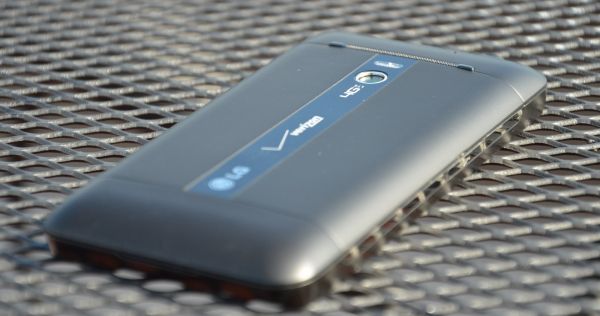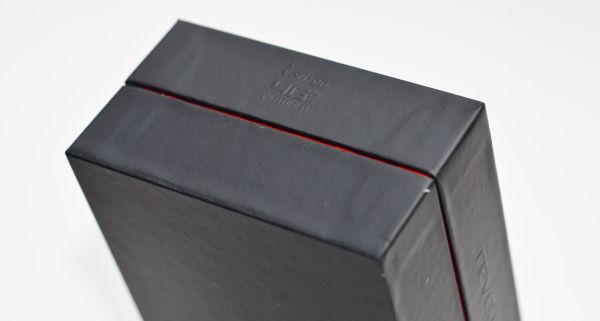LG Revolution: LTE for the Masses
by Vivek Gowri & Brian Klug on June 21, 2011 5:55 AM EST- Posted in
- Smartphones
- Verizon
- LTE
- Mobile
- LG Revolution
As someone who outright refused to pay for a data plan until late last year, I was never really interested in the cutting edge of mobile broadband technology. Beyond knowing that AT&T had decent data speeds and coverage in areas not involving the letters “NYC” or “SFO” and that WiMAX wasn’t nearly as fast in practice as Sprint would have you believe, I didn’t have a whole lot of feel for data plans. I’m a poor college student that lives in a world of campus-wide WiFi; I was always either in a place with wireless internet or in transit to a place with it, so why pay the $30 if I didn’t really need to?
An increasing number of trips out of town forced my hand, and I started to learn more. I got a data plan just as T-Mobile launched its first HSPA+ phone, the T-Mobile G2. It was faaaast, especially in the greater Seattle area. I was seeing download speeds in the 8 Mbps range and upload speeds around 4 Mbps. For a 3G network, that was insane, and T-Mobile has gotten better since then (though I will never be able to get over the 4G stunt that their marketing department pulled). By chance, I recieved a Verizon 3G version of the Galaxy Tab for evaluation, and I found its ~1 Mbps download speeds to be a bit unbearable in comparison. In my review, I said that Verizon really couldn’t get their LTE network deployed quickly enough.
I didn’t know what to expect with LTE until CES. I had heard some insane speedtest numbers through the grapevine, confirmed by Brian during his hands-on with the Thunderbolt at Verizon’s LTE launch event. 18 Mbps down is pretty solid for a Comcast connection, but it sounded borderline crazy for mobile broadband.
| Physical Comparison | ||||||
| LG Optimus 2X | HTC EVO 4G | HTC Thunderbolt | LG Revolution | |||
| Height | 123.9 mm (4.87") | 121.9 mm (4.8") | 122 mm (4.8") | 128 mm (5.03") | ||
| Width | 63.2 mm (2.48") | 66.0 mm (2.6") | 67 mm (2.63") | 67 mm (2.63") | ||
| Depth | 10.9 mm (0.43") | 12.7 mm (0.5") | 13.2 mm (0.52") | 13.2 mm (0.52") | ||
| Weight | 139.0 grams (4.90 oz) | 170 g (6.0 oz) | 183.3 g (6.46 oz) | 172 g (6.08 oz) | ||
| CPU | NVIDIA Tegra 2 Dual-Core Cortex-A9 (AP20H) @ 1 GHz | 1 GHz QSD8650 65 nm Snapdragon | 1 GHz MSM8655 45nm Snapdragon | 1 GHz MSM8655 45nm Snapdragon | ||
|
GPU
|
ULP GeForce | Adreno 200 | Adreno 205 | Adreno 205 | ||
| RAM | 512 MB LPDDR2 | 512 MB LPDDR1 | 768 MB LPDDR2 | 512 MB LPDDR2 | ||
| NAND | 8 GB integrated, up to 32 microSD | 1 GB integrated, 8 GB microSD preinstalled | 4 GB NAND with 32 GB microSD Class 4 preinstalled | 4GB NAND with 16GB microSD preinstalled | ||
| Camera | 8 MP with autofocus, LED flash, 1080p24 video recording, 1.3 MP front facing | 8MP with dual LED Flash and 1 MP Front Facing camera | 8 MP with autofocus and dual LED flash, 720p30 video recording, 1.3 MP front facing | 5 MP with AF and LED flash, 720p video capture, 1.3 MP front facing | ||
| Screen | 4” 800 x 480 IPS | 4.3” 800 x 480 LCD-TFT | 4.3” 800 x 480 LCD-TFT | 4.3" 800 x 480 LCD-TFT | ||
|
Battery
|
Removable 5.6 Whr | Removable 5.5 Whr | Removable 5.18 Whr | Removeable 5.6 Whr | ||
Fast forward to two weeks ago, when I received this LG Revolution on my doorstep. The box was similar to the Thunderbolt and relatively unassuming (from the outside at least; the flame red treatment on the inside was only slightly less subtle), as is the phone itself. It’s a little bit like the Optimus Black, actually, just a lot thicker.
When I first took it out of the box, I texted Brian with “This seriously feels like a gaming notebook circa 2004, the ones that ran hot and were three inches thick.” His response? “Yeah, that’s basically a good analogy for all LTE phones right now.” After years of companies going on and on about the thinnest devices they can make, this is different. As with the Thunderbolt and original EVO 4G, the Revolution is a big F U to the supermodel-thin iPhone 4’s and Galaxy S II’s of the world.

Other than thickness, it’s very similarly sized to the other 4.3” phones on the market, so it’s not a big adjustment to make. When it’s in your pocket, you really don’t notice, and for girls that toss their phones into a purse, it probably doesn’t really matter either. It feels very substantial in-hand, and you can feel all 172 grams when you pick it up. But it’s not uncomfortably large or heavy, it’s just bigger and heavier than you expect. The extra transceiver and antenna hardware has everything to do with that size, but it’s still a chunky device.











24 Comments
View All Comments
Spoogie - Tuesday, June 21, 2011 - link
In spite of the hype, I’m also turned off by 4G but for different reasons than battery life, though it is also an important consideration.When I purchased a 4G modem in January from Verizon, the connection was intermittent. And it would be down completely while searching for backup 3G… totally unacceptable. Verizon claimed that it should be a good connection based on the geography (Bay Area). Tech support was no help.
Recently I was in the market for a new phone, and while standing in the Verizon store admiring the Samsung Charge, low and behold the phone lost connectivity… while the 3G phones right next to it just hummed right along.
This led me to do some further investigating, and others report similar experiences, such as PhoneDog, who claims he has spotty performance with 4G in Philly and believes it isn’t ready for prime.
Although this doesn't exactly constitute a scientific study, I have no faith in it.
VivekGowri - Tuesday, June 21, 2011 - link
I don't know, I haven't tested LTE anywhere other than Seattle, but I've got coverage basically everywhere I've gone here. Once you head up into the northern parts of the area, to Everett and such, I've lost 4G, but the EVDO handover works pretty seamlessly. Signal strength was usually pretty good too, I was impressed.Impulses - Tuesday, June 21, 2011 - link
Sprint's Wimax may not boast LTE's impressive speeds across most markets, but at least you can seamlessly turn it off/on at the flick of a widget, right out of the box, which makes it easier to preserve battery life when you need to.I've got a question, do VZW LTE phones constantly poll the LTE radio even when outside of LTE markets or is there some software list that shuts them off completely outside LTE markets?
I'm particularly curious because PR isn't likely to have true 4G for a while, yet the carriers sell the very same phones here... Sprint has started testing Wimax in some areas (which is curious since this isn't a Clearwire market), but it seems they're still a long way off before any kind of solid announcement.
In the metro area they're literally just testing it on a handful of towers, and it isn't even on all the time... I guess it might be part of the procedure for their Vision deployment, even if there aren't any permanent 4G plans.
Impulses - Tuesday, June 21, 2011 - link
Oops, just saw you mentioned the same thing about Wimax on the article... I had only read the first and last page when I posted the comment. My question about how LTE is polled or detected on a stock phone still stands tho.I know you can disable it thru service menus and there's probably an app or two that can make that easier, but not everyone that buys these phones outside LTE markets is gonna go looking for those.
wintermute000 - Tuesday, June 21, 2011 - link
for now, good quality HSDPA+ is fine (Telstra user in Australia).Most modern droids can get theoretical 14M down, in practice being able to consistently pull down 1Mb+ almost anywhere, is good enough for anything but streaming. (I have to admit on some days, streaming podcasts cuts up a bit) but raw throughput is fine. '
I'd rather go dual core now and get the LTE phones in a year or two for that price
jonup - Tuesday, June 21, 2011 - link
Can we get these phones down to 100g? Everytime I pick up my coworkers' iPhones and Droids one thought comes to my mind "Why are you so fat when you hauling this brick all day"?vision33r - Tuesday, June 21, 2011 - link
Everytime I see a Thunderbolt user on the train, it's usually for a hotspot and then I see them busting out the blackberry for emails.Right now these LTE devices are only for IT pros that have the need for the speed and the companies paying for them.
They are like every new tech devices just the 1st to market but not ready for mainstream adoption until they fix the power consumption and size.
2nd gen to 3rd gen will replace 3G devices they will take 5 years to happen.
antef - Tuesday, June 21, 2011 - link
That speed is very impressive for a mobile broadband network but honestly who cares? No activity on your phone is going to make much use of anything beyond a few Mbps for things like streaming video. Can you provide a single instance where you'll notice 3 Mbps vs 18 Mbps except when running the Speed Test app? In addition to that, with Verizon's rumored upcoming 2 GB cap on $30 data plans, the speeds are even less appealing. What we need is better battery life, higher caps (or no caps), and reliable, good enough throughput anywhere you go (~3 Mbps or so), not absolute blistering speeds.DigitalFreak - Tuesday, June 21, 2011 - link
That's why you buy before the cap gets implemented.VivekGowri - Tuesday, June 21, 2011 - link
Streaming video, mostly. LTE is so fast that we've gone back to smartphone browsing being limited by how fast the phones can render pages.